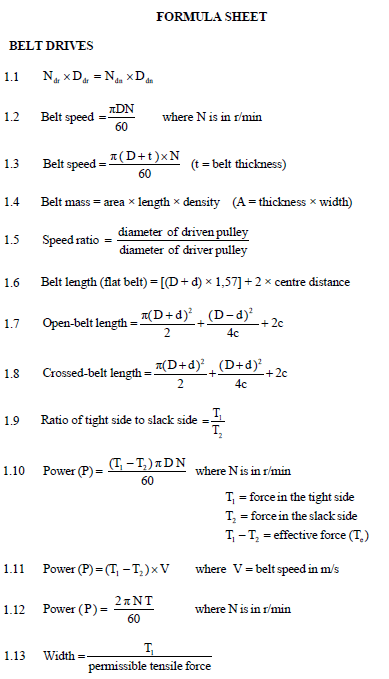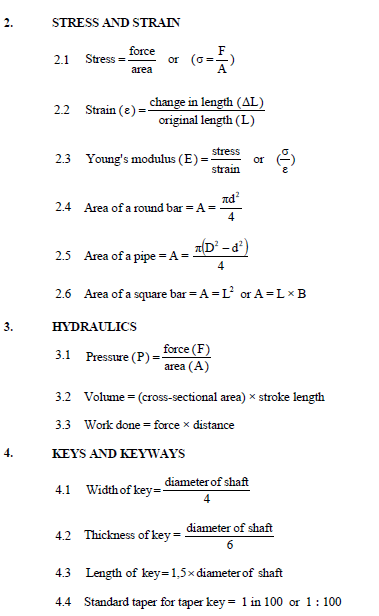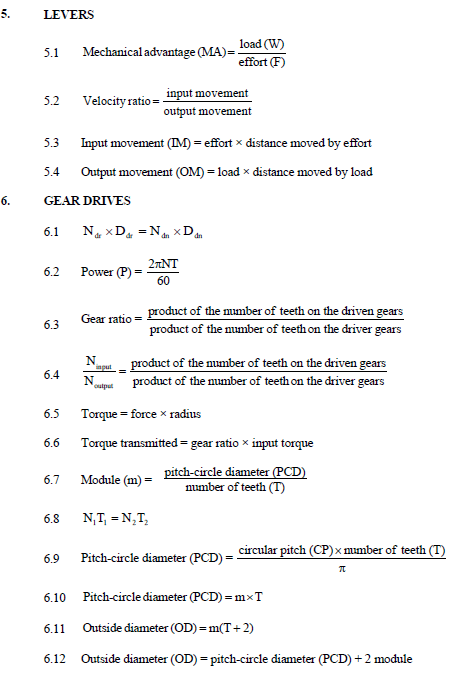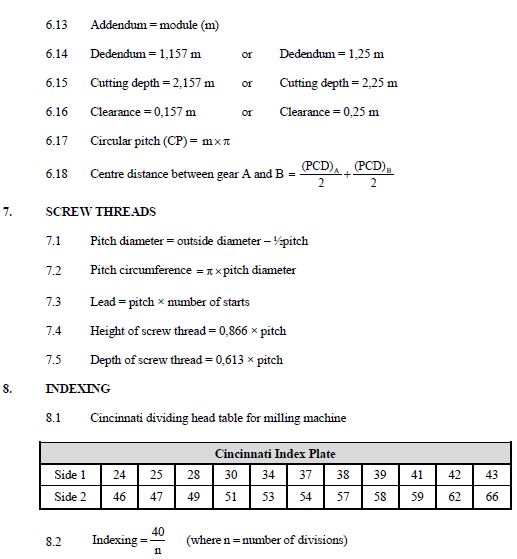MECHANICAL TECHNOLOGY GRADE 12 QUESTIONS - NSC PAST PAPERS AND MEMOS FEBRUARY/MARCH 2017
Share via Whatsapp Join our WhatsApp Group Join our Telegram GroupMECHANICAL TECHNOLOGY
GRADE 12
NSC PAST PAPERS AND MEMOS
FEBRUARY/MARCH 2017
INSTRUCTIONS AND INFORMATION
- This question paper consists of TEN questions.
- Write your centre number and examination number in the spaces provided on the ANSWER BOOK.
- Read ALL the questions carefully.
- Answer ALL the questions.
- Number the answers correctly according to the numbering system used in this question paper.
- Start EACH question on a NEW page.
- Show ALL calculations and units. Round off ALL answers to TWO decimal places.
- Candidates may use non-programmable, scientific calculators and drawing instruments.
- Take the value of gravitational force as 10 m/s-2.
- All dimensions are in millimetres, unless stated otherwise in the question.
- A formula sheet for your use is attached to this question paper.
- Write neatly and legibly.
- Use the guidelines below to assist you in managing your time.
QUESTION | CONTENT | MARKS | TIME (minutes) |
1 | Multiple-choice questions | 20 | 15 |
2 | Safety | 10 | 10 |
3 | Tools and Equipment | 12 | 10 |
4 | Materials | 13 | 10 |
5 | Terminology | 30 | 20 |
6 | Joining Methods | 25 | 25 |
7 | Forces | 30 | 30 |
8 | Maintenance | 15 | 15 |
9 | Systems and Control | 25 | 25 |
10 | Turbines | 20 | 20 |
TOTAL | 200 | 180 | |
QUESTIONS
QUESTION 1: MULTIPLE-CHOICE QUESTIONS
Various options are provided as possible answers to the following questions. Write down the question number (1.1–1.20), choose the answer and make a cross (X) over the letter (A–D) of your choice in the ANSWER BOOK.
EXAMPLE: |
1.1 Which ONE of the following safety measures applies to a power saw?
- Make sure that the cutting speed is set at the highest setting for the best performance.
- Long pieces of material must be supported at the ends.
- Make sure the blade is properly oiled.
- Tighten the blade while the machine is in motion. (1)
1.2 Which ONE of the following safety measures applies to a tensile tester?
- Apply excessive pressure on the tester.
- Use a hammer to remove a test piece.
- Lower the fluid level of the tester.
- Wear eye protection. (1)
1.3 A Rockwell tester is used to test the … of a material.
- tension
- elasticity
- hardness
- brittleness (1)
1.4 Which ONE of the following is a reason for a high carbon-monoxide reading on an internal combustion engine?
- High compression
- Warm valves
- A clogged air filter
- Piston rings set too tight (1)
1.5 An austenite structure is …
- strong and brittle.
- soft and malleable.
- hard and malleable.
- soft and brittle. (1)
1.6 The second arrest temperature (AC2) for carbon steel is …
- 1 000 °C.
- 120 °C.
- 320 °C.
- 800 °C. (1)
1.7 The minimum diameter of a screw thread is measured at the … of the screw thread.
- root
- axis
- crest
- lead (1)
1.8 What is the gear ratio of a Cincinnati dividing head used on a milling machine?
- 60 : 1
- 40 : 1
- 50 : 1
- 30 : 1 (1)
1.9 Which ONE of the following is a common cause of incomplete penetration into a welded joint?
- The welding current was too low
- Slag not removed from the first weld before the second weld was run
- Faulty restart by not restarting at the top of the previous weld run
- Dirty or wet electrodes used when arc welding (1)
1.10 What does the X-ray test on a welded joint detect?
- External defects
- Internal defects
- Surface defects
- Visual defects (1)
1.11 One (1) Pascal can be expressed as …
- 1 kg acting on 1 m2.
- 1 N acting on 1 m2.
- 1 kg acting on 1 mm2.
- 1 N acting on 1 mm2. (1)D
1.12 What is understood by Young's elasticity modulus?
- The force value required to produce a unit area in a tensile test specimen
- The ratio between stress and strain in a metal, provided that the limit of elasticity is not exceeded
- The measurement of the extension or contraction of material due to the load
- The ratio of the deformation because of the application of an external force (1)
1.13 What is represented by point D on the stress-strain graph shown in FIGURE 1.1? 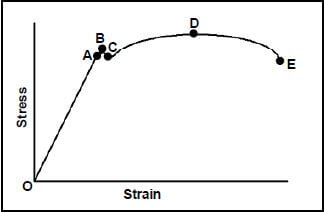
FIGURE 1.1
- The limit of proportionality
- The limit of elasticity
- The minimum stress
- The maximum stress (1)
1.14 Where is extreme pressure (EP) oil used?
- In the engine
- In the power steering
- In the brakes
- In the differential (1)
1.15 What is the purpose of using cutting fluid on a lathe or milling machine?
- Cools the cutting tool
- Makes chips stick to the cutter
- Reduces the quality of the finish
- Serves as a non-lubricant (1)
1.16 FIGURE 1.2 below shows three gears meshing. What is the purpose of idler gear B? 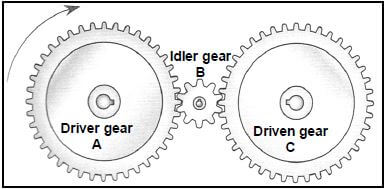
FIGURE 1.2
- Increases the final rotation frequency
- Decreases the final rotation frequency
- Rotates the driven gear in the same direction as the driver gear
- Rotates the driven gear in the opposite direction to the driver gear (1)
1.17 What will the rotation frequency of pulley B be if pulley A rotates at 2 000 r/min, as shown in FIGURE 1.3 below? 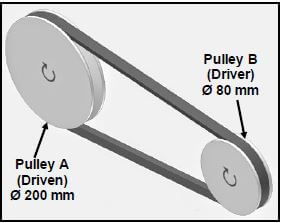
FIGURE 1.3
- 5 000 r/min
- 2 500 r/min
- 2 000 r/min
- 1 000 r/min (1)
1.18 Determine the speed ratio of the chain drive of the bicycle, as shown in FIGURE 1.4. 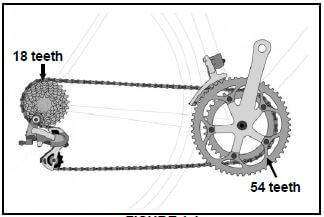
FIGURE 1.4
- 3 : 1
- 1 : 3
- 1 : 18
- 1 : 54 (1)
1.19 The function of a supercharger fitted to an internal combustion engine is to compress air by a/an … action.
- electronic
- mechanical
- electrical
- analogue (1)
1.20 What do you understand by the term boost in respect of turbochargers?
- The pressure that a turbocharger creates in the inlet manifold
- Where the blower is placed before the carburettor
- The centrifugal force to create decompression of the inlet force
- Where the blower is placed after the carburettor (1)
[20]
QUESTION 2: SAFETY
2.1 Which TWO safety precautions must be observed when working with a coil spring compressor? (2)
2.2 State THREE safety precautions that should be observed before pressing a bearing from a shaft using a hydraulic press. (3)
2.3 Thabo uses a beam-bending tester to determine the degree of deflection of a work piece. State TWO safety precautions to be considered when using the beam-bending tester. (2)
2.4 Name ONE distinct safety precaution when using EACH of the following items of testing equipment:
2.4.1 Brinell tester (1)
2.4.2 Gear and bearing puller (1)
2.4.3 Torsion tester (1)
[10]
QUESTION 3: TOOLS AND EQUIPMENT
3.1 Give TWO reasons for low fuel pressure. (2)
3.2 Which precision measuring instrument is used to measure the following accurately:
3.2.1 The depth of a blind hole (1)
3.2.2 The pitch diameter of a V-screw thread (1)
3.3 A depth micrometer reading is shown in FIGURE 3.1. The micrometer is extended with a 50–75 mm interchangeable rod. Give the complete reading with the unit. 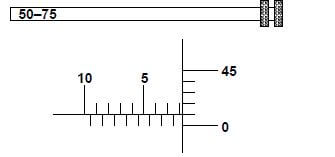
FIGURE 3.1 (2)
3.4 Name TWO measurements that can be taken with a multimeter. (2)
3.5 Explain TWO ways in which you will detect cylinder leakages from an internal combustion engine. (2)
3.6 State TWO uses of the cooling system pressure tester. (2)
[12]
QUESTION 4: MATERIALS
4.1 Name TWO properties of EACH of the following structures of steel:
4.1.1 Cementite (2)
4.1.2 Pearlite (2)
4.2 FIGURE 4.1 shows a diagram. Answer the questions that follow. 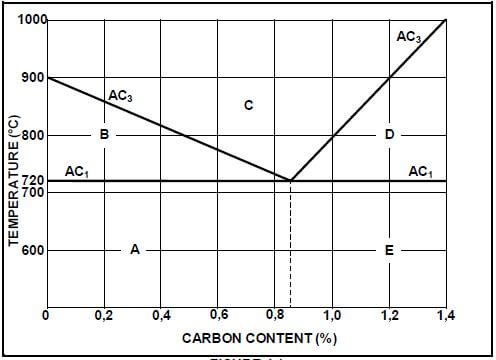
FIGURE 4.1
4.2.1 What is the diagram in FIGURE 4.1 above called? (1)
4.2.2 Label A–E shown on the diagram. (5)
4.2.3 State TWO properties of C on the diagram. (2)
4.3 What is the lower critical temperature for carbon steel with a carbon content of 0,87%? (1)
[13]
QUESTION 5: TERMINOLOGY
5.1 A spur gear with 118 teeth must be cut on a universal milling machine. Calculate the indexing required to cut this gear with the help of a Cincinnati dividing head. (3)
5.2 Use simple line sketches to explain the difference between up-cut milling and down-cut milling on a milling machine. Indicate the work-piece feed and cutter rotation. (4)
5.3 A tapered gib-head key must be made to fit a 102 mm diameter shaft. Calculate the following key dimensions:
5.3.1 The width of the key (2)
5.3.2 The thickness of the key (2)
5.3.3 The length of the key (2)
5.3.4 The thickness of the key at the smaller end (4)
5.4 A spur gear has 60 teeth and a module of 3. Calculate the following in respect of the spur gear:
5.4.1 Addendum (1)
5.4.2 Dedendum (2)
5.4.3 Clearance (2)
5.4.4 Pitch circle diameter (2)
5.4.5 Outside diameter (2)
5.4.6 Cutting depth (2)
5.4.7 Circular pitch (2)
[30]
QUESTION 6: JOINING METHODS
6.1 What welding defect is described as non-metallic solids trapped in the weld metal? (1)
6.2 Name FOUR defects that may be observed during visual inspections. (4)
6.3 State TWO causes of incomplete penetration in a welded joint. (2)
6.4 Name TWO measures to prevent a lack of fusion in a welded joint (2)
6.5 Identify the destructive tests described below that are applied to a welded joint:
6.5.1 To determine the weld hardness and strength (1)
6.5.2 To reveal internal defects (1)
6.5.3 To determine the ductility of the deposit and the heat-affected area adjacent to the weld (1)
6.6 Explain how you will conduct a dye penetration test on a welded joint. (7)
6.7 State ONE function of EACH of the following components on the MIG/MAGS welding equipment:
6.7.1 Wire feed controller (2)
6.7.2 Welding gun (2)
6.8 What is the function of the inert gas used during the MIG/MAGS welding process? (2)
[25]
QUESTION 7: FORCES
7.1 Four pulling forces of 1,2 kN, 2 kN, 3,4 kN and 1,8 kN are acting on the same point, as shown in FIGURE 7.1 below. Determine, by means of calculations, the magnitude and direction of the resultant of the system of forces. 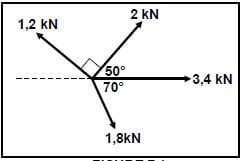
FIGURE 7.1 (13)
7.2 A load of 40 kN is exerted on a brass bush used in a hydraulic press. The outer and inner diameters of the bush are 98 mm and 67 mm respectively. The original length of the bush is 80 mm and Young's modulus for brass is 90 GPa.
Calculate the:
7.2.1 Stress in the bush material (5)
7.2.2 Strain (3)
7.2.3 Change in length (3)
7.3 FIGURE 7.2 below shows a uniform beam that is supported by two vertical supports, A and B. Two vertical point loads of 200 N and 600 N, together with a uniformly distributed force of 80 N/m over the total length of the beam, are acting on the beam. Determine, by means of calculations, the magnitudes of the reactions in supports A and B. 
FIGURE 7.2 (6)
[30]
QUESTION 8: MAINTENANCE
8.1 Define preventative maintenance. (2)
8.2 Why is it important to ensure that a machine is switched off and locked out when doing maintenance on belt drives? (2)
8.3 What is clutch-pedal free play? (2)
8.4 What is meant by the term viscosity index? (1)
8.5 Give TWO reasons why the clutch plate in a motor vehicle's clutch assembly is replaced. (2)
8.6 Why does grease have a very high viscosity? (2) 8.7 What is cutting fluid? (2)
8.8 Give a reason why the viscosity of a cutting fluid should be low. (2)
[15]
QUESTION 9: SYSTEMS AND CONTROL
9.1 FIGURE 9.1 below shows a gear-drive system. Driver gear A on the shaft of the electric motor has 18 teeth that mesh with gear B, with 36 teeth, on a countershaft. There is another driver gear, C, with 16 teeth, on this countershaft, which meshes with a gear D, with 46 teeth, on the output shaft. 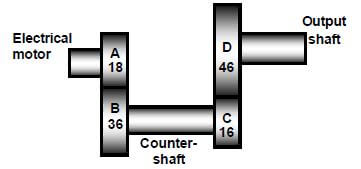
FIGURE 9.1
Calculate the:
9.1.1 Rotation frequency of the output shaft if the electric motor rotates at 1 660 r/min (3)
9.1.2 Velocity ratio between the input shaft and output shaft (2)
9.2 FIGURE 9.2 shows a belt-drive system with a 230 mm driver pulley. The belt speed of the 12 mm thick V-belt is 36 m.s-1. The tensile force in the slack side is 110 N and the ratio between the force in the tight side and the force in the slack side is 2,5. 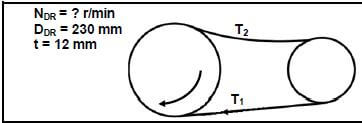
FIGURE 9.2
9.2.1 Rotation frequency of the driver pulley in r/min (revolutions per minute) (4)
9.2.2 Power transmitted (4)
9.3 A hydraulic system is represented diagrammatically inFIGURE 9.3. 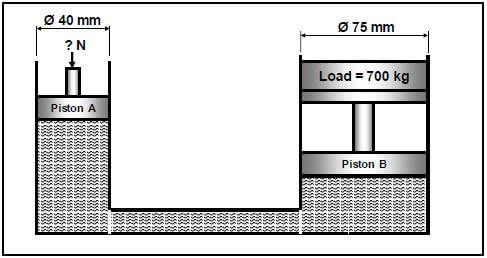
FIGURE 9.3
Calculate the:
9.3.1 Fluid pressure in the hydraulic system when in equilibrium (4)
9.3.2 Effort force needed on piston A to lift the load of 700 kg with piston B (4)
9.4 What is the purpose of the anti-lock brake system (ABS) in a vehicle? (2)
9.5 Explain why a seat belt in a vehicle is described as an 'active' safety feature. (2)
[25]
QUESTION 10: TURBINES
10.1 Name TWO types of impulse turbines. (2)
10.2 FIGURE 10.1 shows a water turbine driving a generator. Answer the questions that follow. 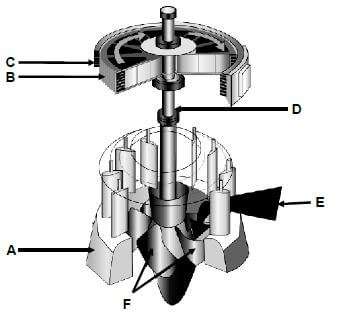
FIGURE 10.1
10.2.1 Identify the type of turbine shown in FIGURE 10.1 above. (1) 10.2.2 Label A–F. (6)
10.2.3 State TWO advantages of the turbine shown in FIGURE 10.1 above. (2)
10.3 State TWO advantages of EACH of the following:
10.3.1 Supercharger (2)
10.3.2 Steam turbine (2)
10.3.3 Gas turbine (2)
10.4 Explain the term turbo lag in terms of a turbocharger. (3)
[20]
TOTAL: 200
